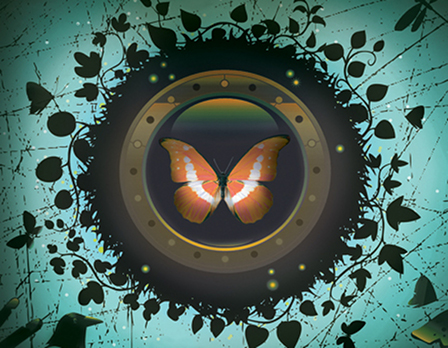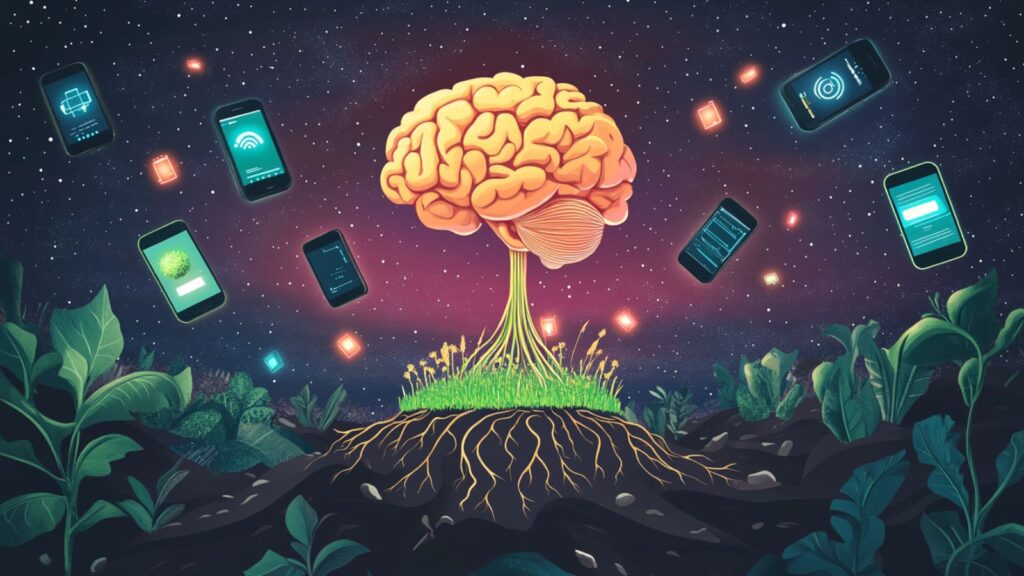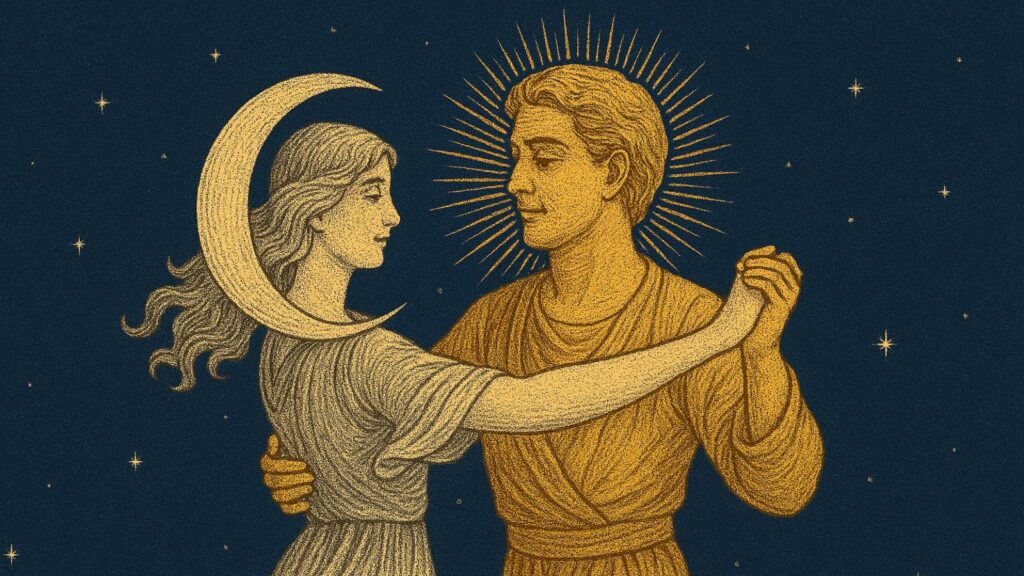If you want to know what a dream shaman of the West would be like, consider Carl Jung, as he is now revealed in his Red Book. He harvested the material for The Red Book — which, with its fine calligraphy and vivid illustrations and decorative features, resembles a medieval illuminated manuscript — from the journals and "black books" he kept during the years of his "confrontation with the unconscious," when he walked the razor's edge between madness and genius. As he describes it, the "spirit of the depths" ripped him out of the comfortable, rational assumptions of the "spirit of our times" and dragged him, night after night, through the terrifying stages of Underworld initiation.
The Red Book is not for the fainthearted. Yes, there are passages of incandescent beauty, perhaps beautiful beyond any others in his writings. There are also vertiginous falls into places of rank terror and screaming madness. In my own reading, there was a moment when I wanted to throw the book violently across the room — and may well have done so, except that the book is the size and weight of a tombstone, and I feared breakages.
In a crater in a dark and terrifying world below, where black snakes threaten to destroy a red sun, he meets the prophet Elijah and his "daughter" Salome, the evil beauty responsible for the decapitation of the biblical John the Baptist. Salome tells Jung — to his amazement and confusion — that they are brother and sister, the children of Mother Mary. Disbelieving and fearing for his sanity, Jung yells at her that she and the Elijah figure are only "symbols." Elijah reproves him, saying, "We are just as real as your fellow men. You solve nothing by calling us symbols." Jung's Elijah also instructs him that "your thoughts are just as much outside your self as trees or animals are outside the body."14
While he is trying to continue to lead a normal life as a prominent psychoanalyst and the father of five children, Jung's sense of reality is shaken by the raw power of his night visions, and by synchronistic phenomena during his days, when he feels the forces of a deeper world pushing through. In December 1913, in a well-cut suit, he gives a polished lecture to the Zurich Psychoanalytical Society. Three nights later, he tells Elijah, "It seems to me as if I were more real here" — in the Underworld — "yet I do not like to be here."15
Jung goes through hell. He converses with a Red Devil. He battles with a Bull God and shrinks him to the size of an egg he can fit in his pocket, then raises up the old horned god again. He howls to a dead moon and a dark sea about combining good and evil, but he doesn't trust his own shouting.
He comes to a library inside a castle in a creepy forest swamp, hoping for a place of sanctuary and reflection. When the librarian asks him to choose the book that he wants, to their mutual surprise he names The Imitation of Christ by Thomas à Kempis, a medieval favorite. Again and again, we notice that this desperate traveler is in his Middle Ages; he turned forty a few months earlier. He debates with the librarian what it would mean to imitate Christ today. He decides that since Christ imitated no one, this would mean going his own way and paying the full price for creating in a way that no one before him has mapped or trodden.
He finds his way to a kitchen attached to the library and converses with a plump, matronly cook. There's a great stir in the air, and a host of the restless dead come flying through, yelling about going to Jerusalem. He demands to know why these dead are not at rest, and their leader tells Jung that he must explain that to them. Jung tells the dead that they can't rest, because of what they failed to do in their lives. The dead clutch at him, and he shouts, "Let go, daimon, you did not live your animal" — by which he means the instinctive, natural life of the senses.
The noise of this altercation is so loud the police come and carry him away to a madhouse, where a little fat professor diagnoses "religious madness" after the briefest of interviews. "You see, my dear, nowadays the imitation of Christ leads to the madhouse."
He is confined in a room between two other patients, one sunk in lethargy, the other with a fast-shrinking brain. He compares himself to Christ crucified between two thieves, one of whom will go up, the other down. His mind turns on the problem of dealing with the dead, whose number, the kitchen scene taught him, is vaster than he had known — "the dead…have fluttered through the air and lived like bats under our roofs from time immemorial." This will require "hidden and strange work," but it is not clear how he can do this from his confinement.
He listens to a voice praising madness, a voice he identifies as his soul: "Madness is a special form of the spirit and clings to all teachings and philosophies, but even more to daily life, since life itself is illogical."
In the night, everything in his room heaves in black billows. The walls become terrible waves. He finds himself now in the smoking room of a great ocean liner, where the little fat professor reappears in beautiful clothes and offers him a drink while telling him he is utterly mad and must be committed. The torpid neighbor from his room reappears and announces he is Nietzsche, and also the Savior.
"This is the night in which all the dams broke,…where the stones turned into serpents, and everything living froze." Back in his locked room at the madhouse, he struggles with entangling webs of words and ideas. He has said to himself, "Do not turn anything you do into a law, since that is the hubris of power." Yet he finds himself pronouncing one law of life after another, in the mode of Nietzsche, the identity claimed by the madman on his left side.
He cannot tell whether it is day or night when he hears a roaring wind and then sees a great wall of darkness advancing on him. "A gray worm of twilight crawls along it. It has a round face and laughs." He opens his eyes and looks up into the jolly round face of the cook. "You're a sound sleeper," she tells him. "You've slept for more than an hour."
Jung thinks he is awake, but of course he is still in a dream and far from his physical home. Unlike those clichéd stories in which the impossible is explained, and the action resolved, when a sleeper wakens from a dream, this is just one awakening within a vast, rushing, inescapable dream.
The moment when I was close to chucking The Red Book across the room came at the point where Jung describes how he was compelled by a woman who called herself his soul to eat part of the liver of a murdered girl.16 I was revulsed, almost gagging. And I forced myself to read on, to go every step with Jung on his frightful shamanic journey through the many cycles of the Netherworld.
As Jung confessed, anyone reading the last chapters of "Liber Primus," the first part of The Red Book, out of context might conclude that the author was crazy. Brilliant and erudite, but crazy. Yet from such perilous adventures out there beyond the roped-in precinct of sanity, Jung derived his ideas about "psychological objectivity," one of the most stimulating elements in his later work. From his dialogues with his dream characters and his efforts to integrate and balance the powers that moved with them, he developed his practice of active imagination. He told the Dutch poet Roland Holst that he developed his work Psychological Types from thirty pages of his Red Book,17 apparently the pages in which the encounters with Elijah and Salome take place and in which — after Jung has been squeezed by a giant black snake until the blood gushes out of him and his head has become that of a lion — Salome tells him, "You are Christ."18
Looking back on this episode in his inner and transpersonal life in 1925, from across the divide of the catastrophic Great War, which some of his visions had foreshadowed, Jung told a seminar: "You cannot get conscious of these unconscious facts without giving yourself to them. If you can overcome your fear of the unconscious and can let yourself go down, then these facts take on a life of their own. You can be gripped by these ideas so much that you really go mad, or nearly so. These images…form part of the ancient mysteries; in fact, it is such fantasies that made the mysteries."19
He commented in his epilogue to The Red Book, nearly half a century later, that he would certainly have gone mad "had I not been able to absorb the overpowering force of the original experiences." Some of the processes he developed in that cause are ones that are suitable for all of us. He wrote his way through, by journaling and then writing up his journals. He sought and created images of balance and integration, which became a fascinating series of mandalas. And he developed the approach he called active imagination, by which, instead of rejecting the characters and contents of dream and fantasy, we work with them, carrying the drama forward toward healing and resolution.
"I fell into the mystery," Jung states after he has been squeezed by the black snake and saluted by Salome.20 Reading The Red Book, we see the enormity of the price Jung paid for his wisdom, and come to appreciate the extent of his courage and eventual self-mastery. This is a record of a thoroughly shamanic descent to the Underworld, and of a long test and initiation in houses of darkness from which lesser minds and feebler spirits might never have managed to find their way back.
Out of the shamanic depth of his personal experience, grounded in science and scholarship and the practice of counseling, Jung crafted a depth psychology in which dreams are central. He saw that most of us live on only one or two floors of the apartment building that is our minds, unaware of all the other levels and rooms. We will see that, in our dreams of houses (and in other dreams), we awaken to what is on the other floors. Jung coined the word individuation for the process of recognizing and integrating what is in the rest of our personal apartment houses.
Jung also invented a vocabulary for what lives on the various levels of those apartment houses. Many of the terms are well-known, if not always well applied, thanks to the work of Jung's followers. There is the Shadow, meaning a part or parts of ourselves that we don't like, don't know, or don't wish to know. The shadow may be negative or positive. Then there is the anima, the woman in man, and the animus, the man in woman. In his later years, Jung contended that "recognizing the shadow is what I call the apprenticeship. But making out with the anima is what I call the masterpiece which not many bring off."21
Conflict between the tenants of the apartment house is inevitable, as are conflict and "contraries" in our world. "There can be no resolution, only patient endurance of the opposites, which ultimately spring from your own nature," Jung says in a letter. "You yourself are a conflict that rages in and against itself in order to melt its incompatible substances, the male and the female, in the fire of suffering and thus create that fixed and unalterable form which is the goal of life….We are crucified between the opposites and delivered up to the torture until the reconciling third takes shape."22 And what is this "reconciling third"? It is a movement toward the Self (which we may call the Higher Self).
This involves the "approach to the numinous" that Jung came to define as the heart of his work: "The main interest of my work is not concerned with the treatment of neurosis but rather with the approach to the numinous….The approach to the numinous is the real therapy and inasmuch as you attain to the numinous experiences you are released from the curse of pathology. Even the very disease takes on a numinous character."23
In his practice, Jung adopted some of the characteristic tools of the shaman, who knows that offering the right song or story can change the behavior of the body and call in the energy of soul. Jung once agreed to see a woman with "incurable" insomnia that had resisted all previous treatment. In her presence, he found himself remembering a lullaby his mother had crooned to him in childhood. He started humming it aloud. The song was about a girl on a little boat on a river full of gleaming fish. It evokes the rhythms of wind and water. Jung's patient was enchanted. From that night on, her insomnia was gone. Her regular doctor wanted to know Jung's secret. "How was I to explain to him that I had simply listened to something within myself? I had been quite at sea. How was I to tell him that I had sung her a lullaby with my mother's voice? Enchantment like that is the oldest form of medicine."24
As dream shaman, Jung knew, and insisted, that dreams show us what the soul wants in life. He said in Memories, Dreams, Reflections: "All day long I have exciting ideas and thoughts. But I take up in my work only those to which my dreams direct me." He was perennially willing both to be mobilized by dreams and to accept course correction from them.
When he was visiting sacred sites in India, he found himself abruptly transported back to Europe on a vital mission. In the dream, Jung is with friends on an island off the coast of southern England. He is standing under the ramparts of a castle dimly lit by candles. He knows the castle as the home of the Holy Grail. But the Grail is not yet here. In the dream, Jung learns that his mission is to swim in the dark to an empty, solitary house, retrieve the Grail that is hidden there, and carry it to its rightful home. Jung read this dream as a call to recognize and operate as a man of the West. "It was as though the dream were asking me, ‘What are you doing in India? Rather seek for yourself and your fellows the healing vessel, the salvator mundi, which you urgently need.'"25
A dream gave Jung a powerful image for self-healing when he was close to death after suffering a heart embolism in 1946. He wrote in bed, in pencil, to an English Dominican priest (Victor White) of a dream that had given him hope. The dream image was of a bluish diamond in the sky, replicated in a quiet, round pool. The quiet simplicity of that spontaneous image, after the stormy complexities of his earlier life and his "confrontation with the unconscious," offered strength and sanctuary.
Near the end of his life, Jung was spurred by a dream to make a decisive move to make his work more accessible to readers outside a rather narrow circle of scholars, scientists, and analysts.
Despite the profusion of new editions and selections from Jung's oeuvre that you'll find at almost any bookstore, not many people even today actually read and comprehend Jung's own writings (as opposed to Jungian explications). His vast scholarship, including his mastery of the classics — from which he sprinkles Greek and Latin throughout his monographs — is formidable and off-putting to many.
In his last major essay, however, Jung managed to put his best and most original ideas in a form that was simple enough to reach a general audience, without diluting or dumbing anything down. He did this because of a dream.
In 1959, Jung participated in some very human, filmed interviews with the BBC presenter John Freeman. After viewing them, the managing director of Aldus Books had a bright idea: why not ask Jung to write a book for a general audience? Jung's answer, when approached by Freeman on the director's behalf, was a flat no. He was now in his eighties and did not want to take the time that remained to him for this. Then Jung dreamed that he was standing in a public place and lecturing to a multitude of people who not only were listening with rapt attention but also understood what he was saying.
The dream changed his mind. Jung now embarked on the book that was published after his death as Man and His Symbols. He conceived it as a collaborative effort and invited trusted colleagues like Marie-Louise von Franz to contribute chapters. His personal contribution was a long essay titled "Approaching the Unconscious." The essay is as simple as Jung gets — which is to say, you must not be dismayed if you come across a word like misoneism (fear of the new) in the first few pages.
The essay is, first and last, about dreams. He completed it just ten days before the start of his final illness, so this work may be called his last testament. It testifies, above all, to the primary importance of dreams in Jung's psychology and in his vision of human nature and evolution. Jung makes the ringing statement that it is "an age-old fact that God speaks chiefly through dreams and visions."26
Excerpted from the book Dreaming the Soul Back Home © 2012 Robert Moss. Printed with permission of New World Library, Novato, CA. www.newworldlibrary.com or 800-972-6657 ext. 52.













